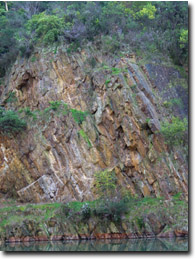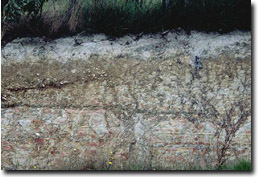Geology and Geomorphology
The oldest rocks in the area are those deposited under deep marine conditions during the Palaeozoic era. Here the Palaeozoic rocks date from the Ordovician period (510 to 435 million years ago (mya), and the Silurian period (435 to 405 mya). After these were deposited, a period of uplift, folding and faulting took place and the deep sea was replaced by a shallow sea and later by dry land. It was during the late Devonian period (about 370 mya), that granitic intrusions, or former molten material, worked its way through the Palaeozoic rocks. The granitic rocks that occur at Mt Martha and Arthur’s Seat were once deep below the surface and have been exposed by subsequent erosion.
 Ordovician rocks exposed in an old quarry at Mt Eliza. | The next oldest rocks on the Mornington Peninsula are the basaltic rocks extruded during the Tertiary period, with the main period of volcanic activity occurring between 20 and 40 mya. Just because there are no rocks or sediments present between 370 and 40 mya does not imply that little geological activity took place here. Periods of glaciation occurred during the Permian period (290 to 250 mya) followed by a period of mass extinction of plants and animals. The Mesozoic era (250 to 65 mya) culminated in the Cretaceous period (145 to 65 mya) during which large volumes of sediment was deposited in a rift valley in southern Victoria, which now is mainly in South Gippsland and the Otway Ranges. Some sediment from this period may have been deposited on the Mornington Peninsula but if it was, it has now been eroded away. Another period of mass extinction occurred at the end of the Cretaceous period and wiped out many plant and animal species, including the dinosaurs. This event ushered in the Cainozoic era (65 mya to the present). This era is subdivided into two geological periods; the Tertiary (65 to about 1.8 mya) and the Quaternary (1.8 mya to the present). The earliest Tertiary sediments are found near the top of Arthur’s Seat, where there are quartz pebbles and stones in the surface soil and the clay subsoil. Most of the Tertiary sediments date from the Miocene epoch (23 to 5 mya) to early Pliocene epoch (about 5 mya) and comprise ferruginous gravel, sand and clays. These sediments mantle earlier rocks and sediments, and where the Tertiary sediments are shallow; it is often difficult to make decisions on the geology on which the soils have developed. In some instances, the sediments are mantled with a layer of wind-blown sand. |
 Tertiary sandstone exposed in road cutting near Langwarrin. | The youngest sediments are those developed on Quaternary sediments. These comprise alluvium from creeks and drainage lines, dune-fields and coastal dunes dating from the early Pleistocene to the present day. The creeks range from broad depressions to incised drainage lines. |


